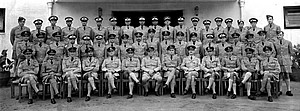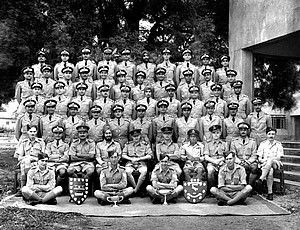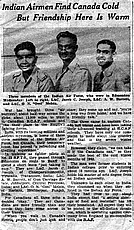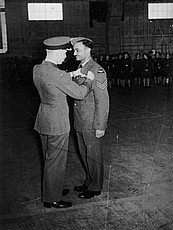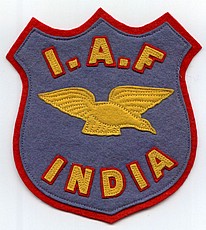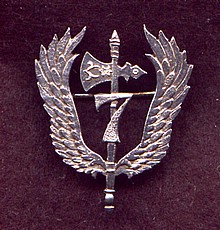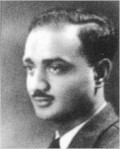 Among the gallantry awards given to IAF personnel for the 1947-48 Operations, only one out of the Four Maha Vir Chakra and 28 Vir Chakra awards was made posthumously. This went to Acting Flight Lieutenant Aloysius William Barrette 3172 GD(P), No.8 Squadron.
Among the gallantry awards given to IAF personnel for the 1947-48 Operations, only one out of the Four Maha Vir Chakra and 28 Vir Chakra awards was made posthumously. This went to Acting Flight Lieutenant Aloysius William Barrette 3172 GD(P), No.8 Squadron.
Aloysius William Barrett was born on 1st November 1920. His father, John Barrett was from the Gun Carriage Factory Estate , Jubbulpore. Aloy, as he was affectionately called, had three brothers, Terence, John and Xavier. He also had two sisters, Winifred and Rose. All the Barrett siblings were born and bought up in Jubbulpore (now Jabalpur).
When the Second World War was in full swing, Allo , as he was fondly called in the family, was quick to enlist as soon as he was old enough. His batch of recruits formed one of the first batchs of Indian Air Force trainees to be sent to Canada for further training as part of the Empire Air Training Scheme. Departing from the practice of batches trained at Indian Air Force establishments who were ‘Officer Cadets’, this particular group of trainees, from the 17th, 18th and 19th Pilots Courses, went to Canada in the rank of LAC. And at the time of receiving their wings, the cadets in this batch were given the rank of Sergeant Pilots in the Royal Air Force, and the pilots sent to the European theatre for some time. Allo Barrett was from the 18th Pilots Course.
The 18th Pilots Course started their ground training from ITW Lahore with their kitting, but soon moved to Beach Candy in Bombay. At the end of the course training at the ITW, Allo Barrett won the Flight Championship Trophy as he was the Flt Commander of the passing out cadets. The Sword of Honour went to Michael Blake, who years later filled in the details on the photograph below. According to Group Captain Blake, the Cadets were given a choice of going to Canada for further flying training on completion of their ITW phase and Barrett was one of those who volunteered. In a strange twist of fate, those who went to Canada were commissioned too late to see proper operational flying during the Second World War, and those who did not go to Canada went to the Burma front and saw action.
In Canada, Allo got trained at the 13 Service Flying Training School (No.13 SFTS) at North Battleford, Saskatchewan Canada. The Barretts were in close touch with Allo throughout his training days, writing letters and exchanging cards. They got to know the progress of his training and how much the Indians were made welcome in Canada. Here were foreign subjects of the king, half way across the world learning to fly and fight. The Canadian populace made sure that the Indians never felt unwelcome.
Allo’s mother was in touch with a Mrs Petitt, whom Allo used to call his ‘Canadian mum’. Mrs Petitt would always make the ‘boys’ welcome in her won home. Once Allo sent back home a newspaper clipping, which was a small story done on him and two other Indian Cadets with him, Jacob Joseph and Omkar Nath Mehta. The report mentions thatit was a general feeling among Indians that the Canadians were more friendly than others they had encountered in their travels. In that news report they mention the only problem that they have encountered in their temporary home was the ‘Canadian Winter’. But ‘if the Canadians can take it, so can we” was the refrain among all the three.
The training was conducted between end of 1943 to early 1945. There was only one casualty in the batch, LAC B Venugopal was lost while low flying in a Harvard at Hume. The rest were given wings on completion of training in the rank of Sergeants.
Allo was with No.13 SFTS till November 44 and possibly up to March 45. Though information is vague as to where the cadets of the Canadian-trained batch were posted after receiving their wings, Rose D’Souza, Aloy’s younger sister confirms that he mentioned spending some time at Biggin Hill in England, flying some missions over Berlin over the closing days of the war. After returning from England he visited here at Sophia College in Bombay and told her about his England experiences. He was on his way to Delhi and stopped over at Bombay.
It is very clear that , after returning to India, the Canadian / European theatre veterans were sent to the OTU at Peshawar and then given commissions in the Indian Air Force. Allo Barrett’s date of return to India was given as 2nd August 1945 in one publication, this was also probably the date he reported at OTU Peshawar. However, for all Sgt Pilots of the Canadian batch, the date of seniority was backdated to the day they enrolled into the IAF. Among the Sgt Pilots thus commissioned, besides Allo were Jaffer ‘Zoot’ Zaheer, Dodsworth, Bala Manivelu, V Srihari, RKB Singh, Les Rondeau among others.
1947-48 Ops
After coming to India, Allo converted to the Hawker Tempest II fighter bomber. He is believed to have spent some time with No.7 Squadron, for there is a BattleAxe pin among his effects. But what is clearly known is that he was part of No.8 Squadron when he flew operations in the Jammu and Kashmir Theatre during the 1947-48 War Operations.
Wg Cdr Don Michael, who as a Flying Officer served with No.8 Squadron remembers Allo Barrett quite well. Aloy was posted to No.8 as the Flight Commander. He was known to the other pilots as ‘Dicky’ and as Don Michael remembers him “a very pleasant soft spoken gentleman and a very good pilot”.
Allo flew over 80 sorties during the very short period of operations that he was associated with the Squadron. Though he was injured on several occasions due to ground fire, he cheerfully carried on his missions. Once attacking enemy positions in the Poonch sector, he was injured by ground fire. However after a short period of recovering from his injury, he again flew in operations.
Once in a mission over Mendhar valley, he was hit in the face by shrapnel from an enemy Anti Aircraft gun while going in for the attack. Although bleeding profusely, he pressed home the attack with determination and destroyed the enemy post. His love for operational flying was a source of inspiration for the other pilots in the Squadron.
 |
A Tempest II pilot preparing for a mission in the Kashmir Valley during the 47-48 Operations. |
Allo was due to leave for home and he had bought various presents to be distributed to his brothers and sisters. However, he never had the chance to meet his family again. On 8th August 1948, he was killed after the Tempest II, in which he was taking off for an air test, crashed at Jammu airfield. A promising life was cut short in an instant.
Rose D’Souza recollects how their family received the news on his death:
“After his crash at Jammu on 8 August 1948 we received 3 telegrams together which my mother opened as my father had left that morning to take a friend to the station. One telegram was from Jammu and two from Delhi. The one from Jammu sent a day late and one from Delhi informed us of his crash and the second telegram from Delhi informed us of the burial.
My Dad telegrammed asking for the burial to be delayed but was told that it was not possible and that he should come to Delhi to collect my brothers effects. My father was so grief stricken that he sent my younger brother Terence who was 24yrs old, so he went with a relative to collect the belongings.
They were given a motorbike, clothing, books and other personal effects. A pen that was broken as it was on his body when he was killed ( which my brother still has ), but his expensive watch they could not find. There were also the gifts he had bought for the family as he was due leave home. After which Aloysius was due to go to Canada for further training as a JetFighter Pilot.”
The Vir Chakra Award.
Soon afterwards, on 26th January 1950, India became a republic and the Gallantry Award system was instituted. Acting Flt Lt A W Barrette (The name was always spelt with an extra ‘e’ in the end in the Official IAF records) was awarded the Vir Chakra medal for “exceptional courage”, “High sense of duty” and “distinguished service rendered”. AW Barrett’s Vir Chakra was the first and only Posthumous gallantry award made for the 1947-48 Operations. and not until the 1965 War, was another Posthumous Vir Chakra award made.
 |
 |
Aloysius’ father , Shri John Barrett receiving the medal from Shri Jayachamaraja Wadiyar, the Governor of Mysore at the republic day parade in Bangalore in 1958. |  |
The Governor of Mysore , Shri Jayachamaraja Wadiyar, presented the Vir Chakra to Aloy’s father John during the Republic Day Parade 1958 in Bangalore, nearly ten years after the Operations. The Citation was read out by the Governor’s Secretary and the medal handed over. Today the Vir Chakra still lies with Aloy’s younger brother Terence Barrett.
Honouring the Martyr
In 1999, after the end of the Kargil operations, the Indian Army instituted a ‘Badge of Honour’ to be presented to all the next of Kin of its soldiers who were killed in action since 1947. The families of the soldiers who lost their lives were given a scroll and a Badge of Honour along with a cash grant of Rs 1 Lakh. The Indian Air Force too instituted a similar practice, giving away an ‘Emblem of Honour’ along with a scroll and cash grant. In a commendable effort undertaken between November 1999 and June 2000, nearly 100 families of the 150 odd officers and airmen who gave their lives in the course of operations were honoured by the IAF. (Read Link ). Only one casualty from the 1947-48 Operations was honoured – Fg Offr Balwant Singh of 7 Squadron.
Fortunately, soon enough contact was established with Aloy’s younger brother, Xavier, who was a priest in Tindini in Madhya Pradesh. In a solemn ceremony, the ‘Emblem of Honour’ Award and the scroll were handed over to him by the Army. Xavier Barrett, donated the Award and the scroll to the Gaurav Sangrahalaya Museum in Jabalpur, where they are displayed today. It is a fitting tribute that they should be on public view in the same district that Aloysius was born.
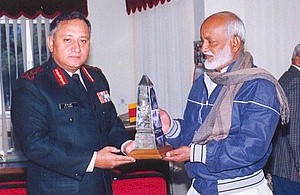 |
 |
| Xavier Barrett receiving the ‘Emblem of Honour’ Award (Right) and with the Scroll (Left). Both the award and scroll are now on display in Jabalpur, the birthplace of Aloysius Barrett. | |
Acknowledgements: Ms Kathleen Barry , Mrs Rose D’Souza , Gp Capt Micky Blake and Wg Cdr Donald Michael.
